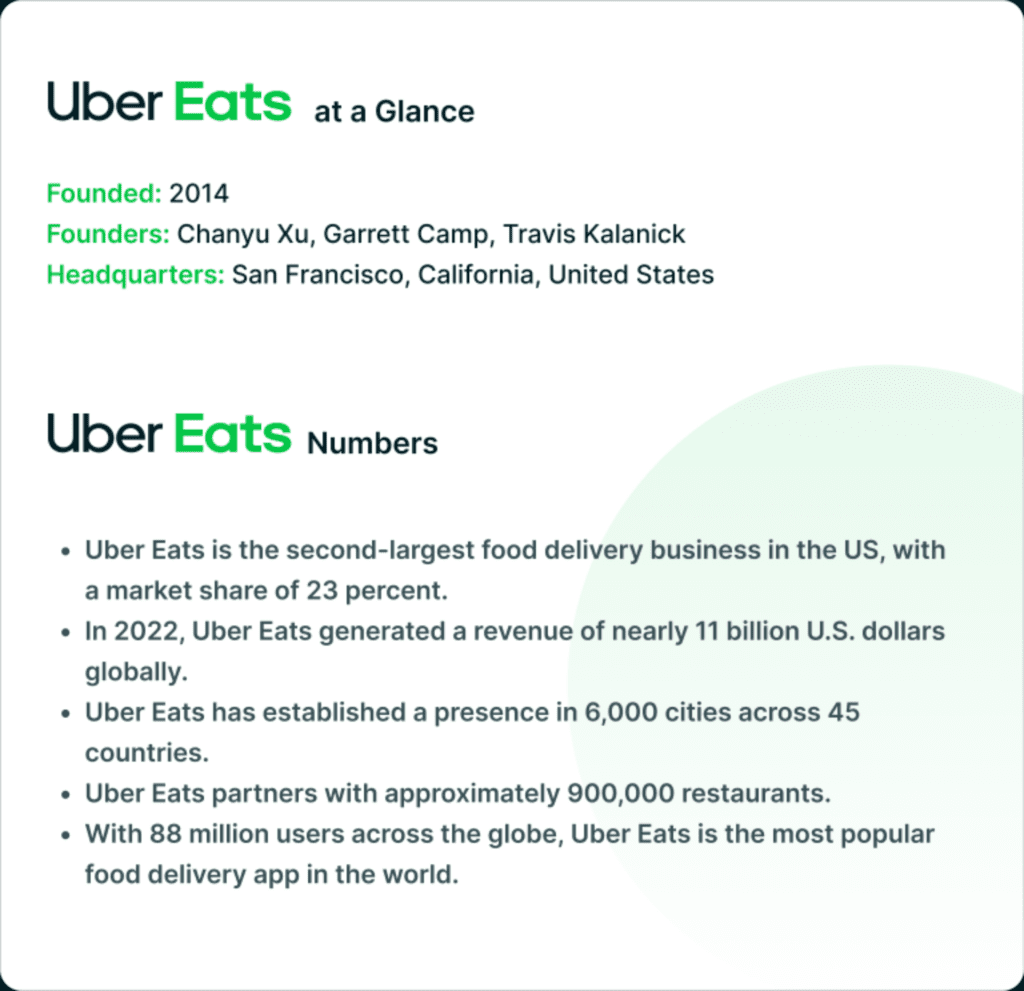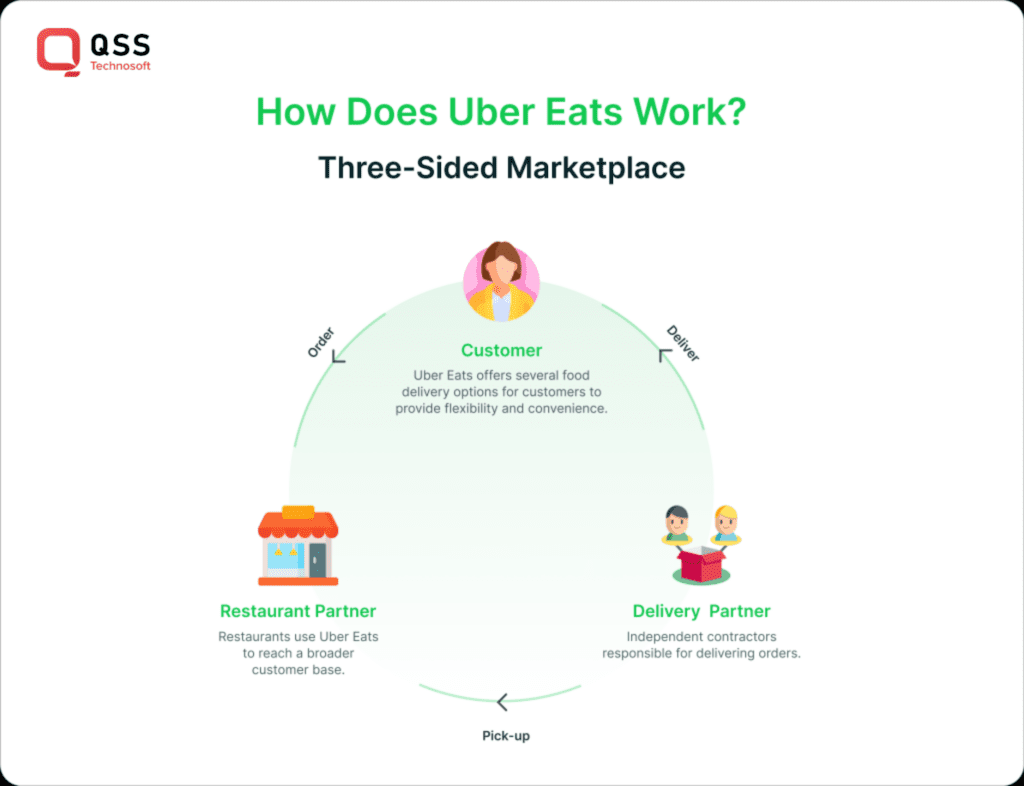The food delivery app industry has experienced a monumental surge of growth in the last few years, largely driven by the integration of cutting-edge technology and a shift in consumer trends. Uber Eats, a brand leading the revolution, has crafted an ecosystem of convenience through its innovative platform. This connectivity encompasses restaurants, consumers, and delivery partners, ensuring rapid delivery of selectable meals with the tap of a finger.
As entrepreneurs look to tap into the lucrative food delivery market, understanding the dynamics of this industry and learning from the success of giants like UberEats becomes paramount. This article delves into the key elements and strategies to craft a successful food delivery app, backed by industry analysis and relevant statistics.
The Landscape of the Food Delivery App Industry
Preparing to develop a food delivery app? Understanding the ever-shifting industry landscape is key. We are witnessing exponential growth across the global food delivery market, driven by the surge in urbanisation, a growing pool of disposable income and an increasing dependence on smartphones. Statistas’s market forecast suggests that online food delivery revenue could reach US$151,526 million by 2023. This trajectory paves the way for a compound annual growth rate (CAGR) of 7.5%, from 2021 to 2025.

Key Players in the Food Delivery App Market
UberEats, Grubhub, DoorDash, and Postmates are among the dominant players in the food delivery sector. UberEats, a subsidiary of Uber, has managed to capture a significant market share by leveraging its existing user base and robust technological infrastructure. Grubhub, DoorDash, and Postmates have also carved out their niches, offering diverse options and unique selling propositions to attract both restaurants and customers.
Also Read our Old Blog : Guide & Cost to develop Uber Eats Like App
Understanding Consumer Behavior
To achieve success with food delivery apps, managers must possess a comprehensive understanding of consumer behavior. Arguably, convenience, variety, and speed determine the surging interest towards food delivery services. A study carried out by McKinsey discloses that a resounding 92% of individuals in the US prioritise the simple experience of online order.
In addition, the ever-present clout of digital channels should not be underestimated. Reports by the National Restaurant Association indicate that a massive 80% of customers favor online to phone orders. In view of this, it is crucial to devise a well-designed app that is effortless to use with every order and delivers a pleasurable user experience.
Also Read Our Page: iphone development company
Key Features of a Successful Food Delivery App
To compete in the food delivery industry, your app must encompass key features that cater to the needs of both restaurants and consumers. Here are some essential features to consider:
User-Friendly Interface:
A simple, intuitive interface that allows users to browse restaurants, select dishes, and place orders effortlessly.
Real-Time Tracking:
Provide real-time order tracking to keep users informed about the status of their orders, from preparation to delivery.
Secure Payment Options:
Integrate secure and diverse payment options, including credit/debit cards, digital wallets, and in-app payment systems.
Also Read Our Blog: Guide to Payment Gateway Development for your Business in 2023
Reviews and Ratings:
Allow users to rate and review restaurants and delivery drivers, fostering trust and transparency.
Personalization:
Implement AI-driven algorithms to offer personalized recommendations based on user preferences and order history.
Robust Search and Filter Options:
Enable users to easily find specific cuisines, dishes, or restaurants through advanced search and filter functionalities.
Notification System:
Implement a robust notification system to keep users informed about promotions, order confirmations, and delivery updates.
Order Customization:
Allow users to customize their orders, accommodating special requests and dietary preferences.
Building Partnerships with Restaurants
The success of a food delivery app hinges on its ability to build and maintain strong partnerships with restaurants. Engaging local eateries, popular chains, and exclusive collaborations can enhance the app’s appeal and provide users with a diverse range of dining options.
Statistics show that restaurants partnering with delivery services experience a substantial increase in revenue. According to a study by Upserve, restaurants that offer delivery services witness a 30% higher average ticket value compared to dine-in orders. This highlights the lucrative potential for both restaurants and food delivery platforms.
Furthermore, establishing a transparent and mutually beneficial revenue-sharing model with partner restaurants is crucial. While UberEats typically charges a commission ranging from 15% to 30%, depending on the market and other factors, finding the right balance is essential to attract and retain restaurant partners.
Ensuring Efficient Delivery Logistics
The logistics of food delivery are intricate and demand meticulous planning. Timely and efficient deliveries are pivotal to customer satisfaction. UberEats, for instance, employs a network of independent contractors who use their vehicles to full deliveries. This model allows for flexibility and scalability, ensuring that the platform can meet varying demand levels.
Investing in a robust delivery fleet or partnering with third-party logistics providers can be a strategic approach. Optimizing delivery routes, employing real-time tracking, and incentivizing delivery drivers through performance-based rewards are essential components of a successful logistics strategy .
The Role of Technology in Food Delivery App
The seamless integration of technology is a cornerstone of successful food delivery apps. From order placement to delivery tracking, leveraging advanced technologies can significantly enhance the user experience.
Mobile App Development :
Invest in a well-designed, responsive mobile app for both Android and iOS platforms. The app should be user-friendly, visually appealing, and capable of handling peak loads seamlessly.
Artificial Intelligence (AI) and Machine Learning (ML):
Implement AI and ML algorithms to analyze user behavior, predict preferences, and offer personalized recommendations. These technologies can also optimize delivery routes and estimate delivery times more accurately.
Ephemeral Messaging
Integrate geolocation services to provide users with a map view of nearby restaurants, real-time tracking of delivery drivers, and accurate delivery estimates.
Payment Gateways:
Collaborate with secure payment gateways to facilitate smooth and secure transactions. Ensure that the app supports various payment options to cater to a diverse user base.
Data Security:
Prioritise data security to protect sensitive customer information. Implement encryption protocols and adhere to industry standards to build trust among users.
Also Read Our Page: hire flutter programmers
Market Expansion and Scalability
The success of a food delivery app is not limited to its initial launch; it requires a long-term vision for market expansion and scalability. UberEats, for instance, gradually expanded its services globally, adapting its business model to suit local preferences and regulations.
Localized Marketing Strategies:
Tailor marketing strategies to each region, considering cultural nuances, dietary preferences, and local cuisines. Localized promotions and partnerships can enhance brand visibility and attract a diverse customer base.
Adaptation to Regulatory Frameworks:
Navigate the regulatory landscape carefully. Regulations related to food safety, licensing, and labor practices can vary significantly from one region to another. Complying with local laws is essential for sustainable growth.
Continuous Innovation:
Stay ahead of the competition by continuously innovating. Introduce new features, partnerships, and promotional campaigns to keep users engaged and attract new customers.
Also Read Our Blog: How Much Does A Logistics And Transportation App Development Cost?
Challenges and Solutions in the Food Delivery Industry
While the food delivery industry presents lucrative opportunities, it also comes with its set of challenges. Addressing these challenges strategically is critical for the long-term success of a food delivery app.
Competition:
The market is highly competitive, with several established players vying for market share. Differentiate your app through unique features, partnerships, and exceptional customer service.
Profitability:
Achieving profitability can be challenging due to the high operational costs associated with delivery logistics, marketing, and technology maintenance. Implementing efficient cost management practices and exploring additional revenue streams, such as subscription services, can help improve profitability.
Regulatory Compliance:
Navigating diverse regulatory landscapes poses a significant challenge. Establish a legal team well-versed in local regulations and compliance requirements to avoid legal pitfalls.
Customer Loyalty:
Building and maintaining customer loyalty is crucial in a market where users can easily switch between competing apps. Implement loyalty programs, discounts, and exclusive offers to retain and attract customers.
Conclusion
The journey from conceptualising a food delivery app to making it a success on par with UberEats involves a multi-faceted approach. By understanding the industry dynamics, consumer behaviour, and the role of technology, entrepreneurs can craft a robust strategy to enter and thrive in the competitive food delivery market. Building strong partnerships with restaurants, ensuring efficient delivery logistics, and adapting to local preferences are key elements of success. Continuous innovation, scalability, and addressing industry challenges strategically will contribute to the sustained growth and profitability of a food delivery app in this dynamic and evolving market.
Why is QSS Technosoft Inc the perfect option for creating a successful food delivery app, like UberEats?
QSS Technosoft Inc is a leader in the app development industry, providing businesses with solutions for their entry into the lucrative food delivery market. Its years of experience and deep knowledge of the market mean that businesses can count on user-friendly, high performing apps that feature all the latest usability specs.
In addition to developing food delivery apps, they also offer restaurant management software, supply chain management solutions and online ordering systems – allowing businesses to take advantage of their comprehensive suite of services related to the food industry.
Because QSS Technosoft Inc has extensive experience in both food industry operations and technology, they can tailor their services to businesses’ unique needs to provide them with a product that meets their goals and objectives. This customer-centric approach ensures that businesses can use the software and services provided by QSS to enhance their presence in the food delivery market.
FAQS
What are the key features that make a successful food delivery app like UberEats?
- User-friendly interface for easy navigation and ordering
- Real-time tracking of orders and delivery status
- Multiple payment options for convenience
- Diverse restaurant options with customizable menus
- Efficient search and filter system for quick results
What should be the target audience for a food delivery app like UberEats?
- Busy individuals, who don’t have time to cook or go out for meals
- College students living on campus or in apartments
- Office workers looking for quick and varied lunch options
- Families with children who want to order food at home
What are some challenges that come with developing a food delivery app like UberEats?
- Ensuring timely and accurate delivery of orders
- Maintaining a consistent standard of quality across restaurants
- Managing customer complaints and refunds
- Keeping up with changing dietary preferences and food trends
How can you make your food delivery app stand out from competitors like Grubhub or DoorDash?
One way to differentiate your app is by offering unique features such as:
- A loyalty program for frequent customers
- In-app reviews and ratings for restaurants
- Personalized recommendations based on past orders and user preferences
- Integration with popular food bloggers or influencers for marketing purposes
What are some potential revenue streams for a food delivery app like UberEats?
- Commission from restaurant partners for each order placed through the app
- Delivery fees charged to customers for each order
- Advertising partnerships with restaurants or food brands
- Premium subscription options for additional features such as free delivery or exclusive discounts.
How can the food delivery app market continue to evolve in the future?
As technology advances and consumer demands change, the food delivery app market is likely to see continued growth and innovation. Some potential changes include:
- Integration with smart home devices for voice-assisted ordering
- Expansion into new markets such as grocery delivery or meal prep services
- Utilizing artificial intelligence and data analysis to improve user experience and personalized recommendations
- Implementation of eco-friendly packaging options and sustainable practices in delivery operations.
We are proud to mention that our work has been recognized by leading B2B reviews and research platforms like GoodFirms, Clutch, MirrorView, and many more.



How to create a Successful Food Delivery App Like UberEats